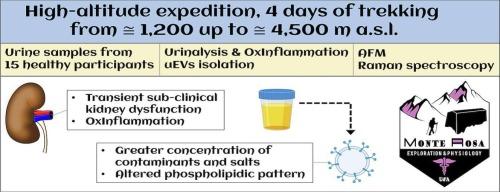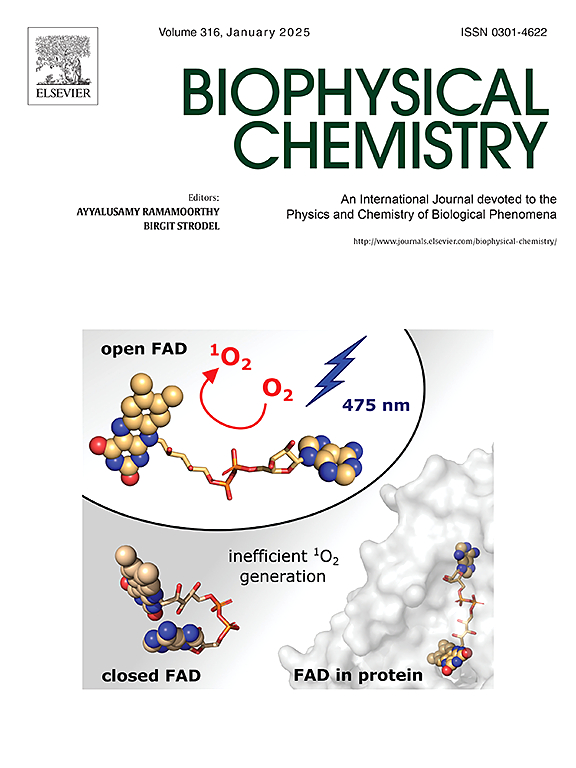Urineprint of high-altitude: Insights from analyses of urinary biomarkers and bio-physical-chemical features of extracellular vesicles
IF 2.2
3区 生物学
Q2 BIOCHEMISTRY & MOLECULAR BIOLOGY
引用次数: 0
Abstract
Humans exposed to altitude hypoxia experience dysfunctions of the urinary system. As a non-invasive, easily manageable and informative biological sample, urine represents a relevant matrix for detecting clinical impairments of urinary system, as well as alterations of other systems and extracellular vesicles (EVs) biology during high-altitude expeditions. Nevertheless, gaps exist in the comprehensive assessment of dysfunction, molecular burden and EVs biology due to high-altitude acute exposure. This study aimed to find a biophysical and biochemical signature of urinary EVs for hypoxia-induced changes in urinary function, putatively accompanied by an oxinflammatory burden. Urine samples of 15 participants were sampled at low and high-altitude during an Alpine project (7 women and 8 men, aged 24-to-63 years and with BMI 17.93-to-30.76 kg/m2) and analysed for: creatinin and albumin, lipid peroxidation, IL6, NO derivatives; atomic force microscopy and Raman spectroscopy were carried out after urinary EVs were isolated through sucrose-gradient ultracentrifugation. Albumin-to-creatinin ratio increased at high altitude, as did IL6 and 8-isoprostane. AFM showed a globular and flattened shape of EVs, although several samples were characterized by a lot of contaminants and EVs lost their prototypal spherical shape; EVs comprehensively maintained their morphology at high altitude. Raman spectroscopy revealed some typical phospholipidic-like pattern, often masked by contaminants of spectra that most often refer to high-altitude samples. Collectively, short-term exposure to altitude hypoxia increased renal concentrating ability, produced non-pathological impairment or renal function, and triggered an oxyinflammatory burden with heterogeneous response of NO system. The combination of AFM and Raman spectroscopy revealed that EVs collected at high altitude more likely are fused together and incorporated into a sediment matrix, and contain contaminants peaks that make the purification process less efficient. The combination of analytical procedures as in the present study offers novel possibilities to detect the biological and clinical effects of high altitude on renal system.

高海拔地区的尿指纹:通过分析尿液生物标志物和细胞外囊泡的生物物理化学特征获得启示。
暴露于高原缺氧环境中的人类会出现泌尿系统功能障碍。尿液作为一种非侵入性、易于管理且信息丰富的生物样本,是检测高海拔探险期间泌尿系统临床损伤以及其他系统和细胞外囊泡(EVs)生物学变化的相关基质。然而,在全面评估高海拔急性暴露导致的功能障碍、分子负担和EVs生物学方面还存在差距。本研究旨在寻找尿液EVs的生物物理和生物化学特征,以了解缺氧引起的泌尿系统功能变化(可能伴有氧化炎症负担)。在一次阿尔卑斯项目中,在低海拔和高海拔地区采集了 15 名参与者的尿样(7 名女性和 8 名男性,年龄在 24 至 63 岁之间,体重指数在 17.93 至 30.76 公斤/平方米之间),并分析了肌酐和白蛋白、脂质过氧化、IL6、NO 衍生物;通过蔗糖梯度超速离心法分离尿液 EVs 后,进行了原子力显微镜和拉曼光谱分析。在高海拔地区,白蛋白与肌酐的比率增加,IL6和8-异前列腺素也增加了。原子力显微镜(AFM)显示,EVs呈球状和扁平状,但有几个样本含有大量杂质,EVs失去了球状的原型;EVs在高海拔地区全面保持了其形态。拉曼光谱显示了一些典型的磷脂样模式,这些模式往往被高海拔样本的光谱污染物所掩盖。总之,短期暴露于高海拔缺氧环境中会增加肾脏的浓缩能力,产生非病理性的肾功能损害,并引发氧化性炎症负担和氮氧化物系统的异质性反应。结合原子力显微镜和拉曼光谱分析发现,在高海拔地区采集的肠病毒更有可能融合在一起并融入沉积物基质中,而且含有杂质峰,从而降低了纯化过程的效率。本研究结合了多种分析方法,为检测高海拔对肾脏系统的生物和临床影响提供了新的可能性。
本文章由计算机程序翻译,如有差异,请以英文原文为准。
求助全文
约1分钟内获得全文
求助全文
来源期刊

Biophysical chemistry
生物-生化与分子生物学
CiteScore
6.10
自引率
10.50%
发文量
121
审稿时长
20 days
期刊介绍:
Biophysical Chemistry publishes original work and reviews in the areas of chemistry and physics directly impacting biological phenomena. Quantitative analysis of the properties of biological macromolecules, biologically active molecules, macromolecular assemblies and cell components in terms of kinetics, thermodynamics, spatio-temporal organization, NMR and X-ray structural biology, as well as single-molecule detection represent a major focus of the journal. Theoretical and computational treatments of biomacromolecular systems, macromolecular interactions, regulatory control and systems biology are also of interest to the journal.
 求助内容:
求助内容: 应助结果提醒方式:
应助结果提醒方式:


